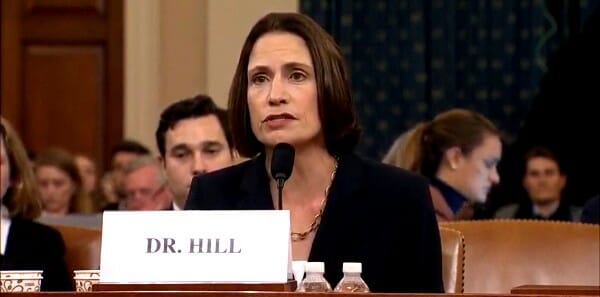
Fiona Hill is best known for testifying against President Trump in the House impeachment investigation one year ago, but declassified documents set for imminent release will show she had the distinction of introducing former British spy Christopher Steele to the primary source of the infamous dossier of Russian propaganda that fueled the Russia-collusion probe, said John Solomon in his podcast.
According to Steele’s debriefings, Hill, a Russia expert on the National Security Council, connected the former MI6 spy to the source, the Ukraine-born, Russian-educated researcher Igor Danchenko, said Solomon.
Hill co-wrote a Brookings Institute paper with Danchenko in 2010. She also worked with Steele while he was a British intelligence officer. She said she believed Steele was “played” by Russian disinformation in the production of his dossier.
“Isn’t that amazing that someone that would testify against the president in the 2019/2020 impeachment proceedings had an earlier role getting Christopher Steele on his dirty dossier?” Solomon said.
The documents set for release, he said, will show that the collusion narrative was created and leaked to the news media to “neutralize Hillary Clinton’s concern that her email scandal had not yet gone away.”
“It was actually a calculated political act, and you’ll see in Christopher Steele’s own acknowledgement that that was the reason that James Comey’s continued actions to keep the case open drove him to leak and to plant what turned out to be a false story,” he said.
The Obama FBI and Justice Department used the Steele dossier – which was funded by the Democratic National Committee and the Hillary Clinton campaign – as primary evidence to obtain warrants to spy on Trump volunteer adviser Carter Page.
Among the claims of the debunked dossier is that Trump funded Russian hacking, his attorney secretly visited Prague to meet with operatives of Russian President Vladimir Putin, and there was a well-developed conspiracy between the Trump campaign and the Kremlin.
A report by Justice Department Inspector General Michael Horowitz found intelligence agencies had warned the FBI that the dossier contained Kremlin disinformation.
Politico reported in September 2019 that Hill and Steele had “known each other for years, beginning when Hill was working on Russia at the National Intelligence Council and Steele was on MI6’s Russia desk.”
“She had a high opinion of Steele, and thought he was very smart,” a source told Politico.
Last October, White House Chief of Staff Mark Meadows disclosed that Trump had ordered him to release transcripts of FBI interviews with Danchenko.
In July, the Washington Times described Danchenko as a “shadowy figure” who “worked in the U.S. and traveled to Moscow to find supposed dirt on candidate Donald Trump.”
Washington lawyer Mark E. Schamel confirmed to the New York Times that Danchenko was his client and had been “identified as one of the sources who provided data and analysis” for the Steele dossier.
Senate Judiciary Committee Chairman Sen. Lindsey Graham, R-S.C., released a 60-page declassified FBI report that detailed three interviews with Danchenko in January 2017.
The subject’s name was omitted, and Danchenko was referred to only as Steele’s “primary sub-source.”
Danchenko was on the payroll of Steele’s investigative London firm, Orbis Business Intelligence.
The Washington Times noted the New York Times, “a prime peddler of a Trump-Russia election conspiracy narrative that was ultimately debunked, turned the Danchenko revelation into an anti-White House story.”
The New York Times headline was “The F.B.I. Pledged to Keep a Source Anonymous. Trump Allies Aided His Unmasking.”
But in a March 2017 interview with the FBI, Danchenko said his sub-sources’ information was not worth “a grain of salt.”
The FBI, nevertheless, continued to use the dossier to advance it’s Trump-Russia probe.
Via Wnd
